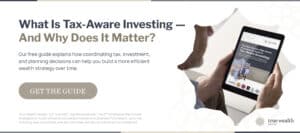Key Takeaways
- ETFs are tax-efficient compared to mutual funds because of their in-kind redemption process — but they don’t actively manage your taxes.
- Other strategies such as direct indexing, tax-loss harvesting, and charitable giving can enhance efficiency, though each has limits.
- True Wealth Design’s Tax-Aware Long-Short (TALS™) framework integrates these benefits into one sophisticated approach that proactively offsets gains and improves after-tax wealth.
ETFs are often hailed as one of the greatest financial innovations of our time — and for good reason. They offer diversification, low fees, and a structure designed to minimize taxes. But for affluent investors, especially those with significant taxable assets, the question isn’t “Are ETFs tax efficient?” It’s “Are ETFs efficient enough?”
While ETFs can reduce taxable events inside the fund, they can’t manage your personal tax circumstances. For investors seeking deeper control — where portfolio design and tax planning work hand in hand — there are more powerful, more nuanced solutions available.
At True Wealth Design, we help clients optimize not only their investments but also their after-tax returns. ETFs can be a valuable component, but strategies like Tax-Aware Long-Short (TALS™) can take tax efficiency to an entirely new level.
Why ETFs Are Tax Efficient (And How That Works)
Exchange-Traded Funds (ETFs) are structured to minimize taxable capital gains distributions. Unlike mutual funds — which must sell holdings to meet investor redemptions — ETFs use an in-kind creation and redemption process.
When large investors want to redeem shares, the ETF provider delivers a basket of underlying securities rather than selling them for cash. This allows the fund to remove low-cost-basis positions from its holdings without triggering a taxable event for shareholders.
According to Morningstar’s 2024 ETF Tax Efficiency Report, fewer than 4% of U.S. equity ETFs projected to distribute capital gains. Among those that do, most are expected to pay out less than 1% of the fund’s net asset value. By contrast, active mutual funds distributed an average of 5–8% — a major difference for investors in higher tax brackets.
Additionally, ETFs typically have lower turnover, meaning fewer sales within the fund, further reducing realized gains. The result is that investors can defer paying capital gains until they personally sell ETF shares, allowing assets to compound longer before taxation.
ETFs, in other words, are tax-efficient by design — but that efficiency stops at the fund level.
The Limits of ETF Tax Efficiency
For most investors, ETFs are a significant improvement over mutual funds. But for high-net-worth individuals, efficiency at the fund level isn’t enough.
Three major limitations often go overlooked:
- ETFs don’t manage your personal tax situation. They can’t harvest losses or offset gains from your broader financial life, such as real estate sales or stock options.
- ETF sales still create taxable events. When you sell shares, you realize your own gains, regardless of how efficient the fund itself may be.
- ETFs can’t coordinate across your portfolio. They operate in isolation, not in collaboration with other holdings or strategies.
Consider an investor who sells their business for $3 million in taxable gains. No ETF, regardless of efficiency, can generate offsetting losses or credits. True investment tax management requires integration at the portfolio level, not just at the fund level.
As we discuss in greater detail in our Tax-Aware Investing in Practice guide, managing taxes intelligently means aligning investment design, trading behavior, and wealth planning. That’s where more advanced strategies come in.
Other Tax-Efficient Investment Strategies Worth Considering
While ETFs are a cornerstone of modern portfolios, other approaches offer added layers of tax control — each with its own strengths and weaknesses.
1. Direct Indexing
Direct indexing allows investors to hold the individual securities of an index rather than a single ETF. This gives them control over each security’s tax lot, enabling precise tax-loss harvesting when certain stocks decline.
The key benefit of this approach is its customization and potential for greater tax efficiency. However, it has one notable limitation: it only captures losses on the long side, meaning that when markets broadly rise, as they tend to do over time, opportunities to harvest losses become limited.
2. Tax-Loss Harvesting Systems
Automated tax-loss harvesting systems, commonly used by digital platforms and robo-advisors, monitor portfolios for loss opportunities and sell losing positions to offset realized gains elsewhere.
Their main benefit is efficiency and automation, allowing investors to capture losses without constant oversight. However, they work best in volatile markets and often operate with limited coordination across a broader wealth strategy.
3. Asset Location
Placing income-producing or high-turnover assets in tax-deferred accounts such as IRAs or 401(k)s, while keeping tax-efficient assets like ETFs or municipal bonds in taxable accounts, can help reduce annual tax drag.
The approach is effective, though it doesn’t address realized capital gains within taxable accounts or mitigate the impact of major liquidity events.
4. Charitable and Philanthropic Strategies
Donating appreciated stock or contributing to a donor-advised fund enables investors to avoid paying capital gains tax on the appreciation while also receiving a charitable deduction. This strategy serves a dual purpose by reducing taxes and supporting philanthropic goals, though it comes with the limitation that the assets are permanently removed from personal use.
***
Each of these strategies offers a way to mitigate taxes — but none provides continuous, dynamic management across both gains and losses. For that, investors are turning to the next evolution: Tax-Aware Long-Short (TALS™) investing.
The TALS™ Advantage: Combining the Best of All Worlds
The Tax-Aware Long-Short (TALS™) framework builds upon the core strengths of all the above strategies while solving their key limitations.
Like ETFs, it seeks broad market exposure. Like direct indexing, it allows for precise tax control. Like tax-loss harvesting, it continuously manages realized losses — but it goes further by adding a short component that actively generates additional, usable tax losses that become a tax asset for investors.
How TALS™ Works
TALS™ combines two coordinated portfolios to seek growth and tax efficiency. The long portfolio holds positions that capture market exposure and long-term appreciation potential. The short portfolio is managed dynamically, realizing gains and losses in a way that offsets taxable income elsewhere in the investor’s broader portfolio.
Together, these components enable investors to pursue returns while actively managing tax impact in real time. Rather than simply deferring taxes, TALS™ integrates them into the portfolio design itself — making tax management an ongoing part of investment strategy, not an afterthought.
Independent research supports this approach. Studies such as AQR’s Beyond Direct Indexing: Dynamic Direct Long-Short Investing (2023) find that combining long-short tax management can boost after-tax wealth by roughly 1–2% per year compared to traditional direct indexing. For a $1,000,000 portfolio, that equates to $10,000 to $20,000 better in year one. Over time, that compounding effect can result in significantly higher long-term portfolio value.
For a deeper look at this approach, download our comprehensive eBook: The High-Income, High-Asset, Professional’s Guide to Tax-Aware Investing.
Choosing the Right Strategy for Your Wealth
Each approach to tax efficiency serves a purpose:
| Strategy | Best For | Tax Control Level | Typical Investor Profile |
| ETFs | Passive, low-turnover investors | Low | General investors |
| Direct Indexing | Investors wanting customization | Moderate | Taxable portfolios >$250K |
| TALS™ | SEC Accredited investors seeking enhanced tax benefits | High | Higher-net-worth investors with larger taxable assets > $1M |
At True Wealth Design, we don’t believe one size fits all. For some clients, ETFs and asset location may provide enough benefit. For others, integrating TALS™ within a holistic plan, potentially alongside ETFs or charitable giving, offers the best balance of growth, flexibility, and tax efficiency.
Step Beyond Passive Tax Efficiency Strategies
ETFs transformed investing by making low-cost, diversified portfolios more accessible and tax-efficient. But their efficiency is structural, not strategic: it stops where your personal tax reality begins.
Today, high-net-worth investors have access to a new generation of tax-aware strategies that manage gains and losses dynamically, not just passively. TALS™ represents the pinnacle of that evolution, offering the sophistication of institutional management with the personalization of fiduciary advice.
To explore how a TALS™ or integrated tax-aware strategy could enhance your wealth management goals, contact a True Wealth Design professional.
Disclaimer: This article is for educational purposes only. The TALS™ strategies referenced apply to Accredited Investors or Qualified Purchasers per SEC regulations.


